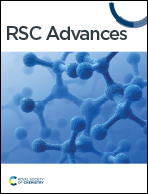A polystyrene-based ESIPT fluorescent polymeric probe for highly sensitive detection of chromium(vi) ions and protein staining†
Abstract
A “two-step” preparation method of an excited-state intermolecular proton transfer (ESIPT) fluorescent polymer (f-PP) is reported here. The synthesis of f-PP involves the acetylation of polystyrene and a “multicomponent one pot” reaction. The as-prepared polymer bears a group of ESIPT fluorescent units, enabling it to exhibit high brightness, moderate solubility and ESIPT fluorescence. F-PP gives off tautomeric bright green fluorescence under UV-tamp and the dual-emission could be specifically suppressed by Cr(VI). This phenomenon cannot be elicited by other competing species. On this basis, an ESIPT polymeric probe-based method for the determination of Cr(VI) was developed, offering high sensitivity (19.5 nM) and selectivity. The f-PP was successfully used to detect Cr(VI) in real water samples by standard adding methods, indicating its application feasibility.



 Please wait while we load your content...
Please wait while we load your content...